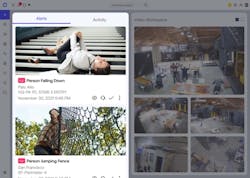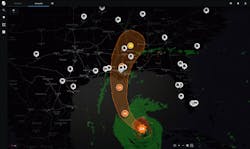Pierre Bourgeix, Chief Technology Officer and Founder of ESI Convergent LLC, a global security consultancy, affirms this trend. “Data architecture, sovereignty, and controls are critical for businesses seeking to do more than just dabble in the emerging AI, Machine Learning, and business intelligence arenas.”
The First Time Exhibitor’s Pavilion at GSX 2023 had something for everybody: new identification systems, gridless power technology, applied AI, and solutions to improve trust when accessing the internet. The cybersecurity pavilion continued to expand with intrusion detection systems and solutions using playbooks that allow an IT administrator to leverage other industry professionals’ experiences. This collaboration is a popular theme for GSX attendees, so they can deploy enhanced cyber intrusion protection, to avoid, for example, a ransomware attack that could interrupt life-providing utilities and power.
Next-generation user interfaces were on display; one solution provider that stood out is Ambient AI, whose solutions drive enhancements to business operations, with a strong focus on reducing risk and establishing productivity goals. Ambient AI's Context Graph, introduced at GSX, monitors and connects multiple pieces of intelligence for calculating risk. It considers the context of the location where the object in question is in space, the time of day, the behavior signatures of these objects in a scene relative to others, the movement of this object, how it interacts with its environment, and the type of objects that are under question, whether it's a person, car, animal or other unidentified object.
A person climbing a fence might be following an employee who is traveling into a secure location. That intruder might be carrying a weapon, and that intrusion represents an opportunity to identify all of these as a threat signature. The context graph is already populated with over 100 threat signatures and allows users to adapt the platform as the threat environment changes.
This supports four categories of users: operators, investigators, the response team and the leadership. Operators need to prioritize interventions and improve their speed of response, and that includes responders that will leverage mobile devices. Investigators cannot wait anymore until after the threat has been resolved. The new AI-powered investigation feature can potentially reduce an investigation down from a full day to less than an hour.
Leveraging computer vision, plus data from additional sensors, the event-based search in Ambient AI's investigation application searches across an end user’s global network filtering by event time, location, stream and site. There's no need to wait for a video processing to complete. If that intruder climbing a fence has a weapon and is following an employee entering a high-risk space, all threats and behavior are analyzed in real-time to provide the most appropriate mitigation strategy.
At GSX it was evident that automation and augmentation are sought-after tools presented by many solution providers. The ability to repeat a scripted process and improve that process by augmenting the security operator and investigator was also a common theme.
Exhibitors like FaceFirst and Ambient AI showed opportunities for data privacy and protection. Ambient AI’s metadata is exchanged in the cloud, preserving the video footage to remain secure, within a customer's network. The FaceFirst platform leverages multiple safeguards for privacy protection in their facial matching software. FaceFirst has partnered with the Loss Prevention Foundation to add biometric privacy and compliance content to LPS’ own certification programs for retail loss prevention leaders. These include best practices for responsible biometric data handling, purging human verification data, encryption, face feature redaction, anti-profiling, and the purge of collected data automatically at regular intervals. In FaceFirst’s solution, ID approval and viewing of enrollment images is managed only by authorized individuals. FaceFirst’s technology partners include Johnson Controls, Genetech, numerous camera solution providers and NVIDIA.
Of particular significance, on this date, NVIDIA, Reliance Industries, and Tata Consultancy Services are working together to build AI infrastructure that is an order of magnitude more powerful than the fastest supercomputer in India. The effect is that solution providers like FaceFirst can leverage NVIDIA’s extremely powerful platform for advanced AI computations.
What will the command center of the future? At this GSX, the focus on the global security operations center and local SOC continues. These are points where a variety of systems and solutions come together to provide a common operational picture, mitigate threats, and promote enhanced communication during an incident.
Gunshot Detection Systems
Gunshot detection systems are well represented on the GSX exhibit floor. These include Shooter Detection Systems, Databuoy, and Amberbox gunshot detection. This year gunshot detection systems have a new compliance requirement in Kari’s law and the Ray Balm Act. These require enhanced first responder intelligence such as the exact location within a building, including elevation, communicated through the Public Safety Answering Point (PSAP), to public safety agencies and their first responders.
Early in the year, as reported by Security InfoWatch, Shooter Detection Systems was already in compliance providing an end-to-end solution, linking the indoor, and future outdoor incident locations. This benefits the security operation center at the facility where the incident is taking place, as well as the Public Safety answering point. They both have the opportunity for improved situational awareness that can be shared with first responders.
Also at GSX, and also positively impacting risk management through AI, DataMinr has introduced DataMinr pulse for corporate security that allows threats to be discovered, and intelligence to be communicated enterprise-wide. Dataminr is one of two companies at GSX leveraging generative AI.
The well-known chatbot GPT 3.5 is an example of a generative AI solution with a simple text interface and fast answers. Generative AI in the Dataminr user interface presents a unified view of all activity event details, tasks, and alerts. You are most likely aware of Dataminr, with its geolocation and geofencing social media intelligence system for breaking news and accurate weather reporting. One example is Radio Free Europe, who uses Dataminr to relay stories across 27 countries. This links 700 full-time journalists and 1,300 freelance reporters with verified intelligence and news gathering.
Proactive weapons detection, detection of contraband, and dangerous substances were highlighted by Athena Security and Astrophysics Inc. Athena Security’s easily installed multisensor portal provides for instant weapons detection. It is an AI solution powered with the incredible efficiency of a simple tablet device.
The database categorizes the contents based on their atomic number and includes the detection of liquids, explosives, and different metallic materials, isolating each, so each scan is an extremely efficient one. Visitors can proceed rapidly into a secure facility.
Steve Surfaro is Chairman of the Public Safety Working Group for the Security Industry Association (SIA) and has more than 30 years of security industry experience. He is a subject matter expert in smart cities and buildings, cybersecurity, forensic video, data science, command center design and first responder technologies. Follow him on Twitter, @stevesurf.
About the Author

Steve Surfaro
Steve Surfaro
Steve Surfaro is Chairman of the Public Safety Working Group for the Security Industry Association (SIA) and has more than 30 years of security industry experience. He is a subject matter expert in smart cities and buildings, cybersecurity, forensic video, data science, command center design and first responder technologies. Follow him on Twitter, @stevesurf.




